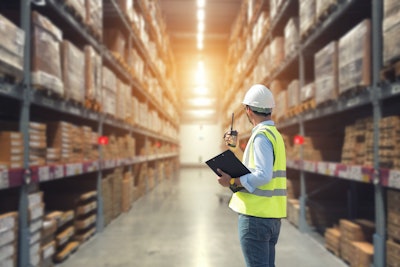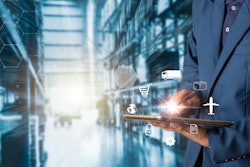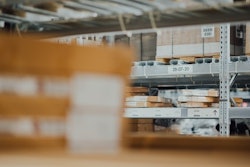
“Smile! You’re on camera.” Security notices and signs bearing such a greeting are still common across many business environments and likely scatter the landscape of your warehouse. However, these days those simple words have more teeth behind them.
Over the past 10 years video capabilities have evolved well beyond loosely networked camera systems and simple monitoring. As the catch phrase above implies, historically, closed loop CCTV surveillance systems were put in place as more of a visual deterrent, which was helpful to combat internal theft and provide the illusion of security. And for many scenarios that was enough. But as the aftereffects of the global pandemic linger, there is a renewed emphasis on safety and security in the warehouse and in turn the demand for “connected” cameras and video analytics has exploded.
According to a report from Fortune Business Insights, the global video analytics market is expected to reach $6.35 billion by the end of this year. In just the next five years, that figure is expected to increase by nearly another quarter. When combined with analytics, video cameras can serve as the ultimate sensor providing real-time insight into a wide range of critical warehouse functions. And while safety may be the most top-of-mind use case in the warehouse, it’s just the beginning.
From loss prevention to staffing optimization and machinery efficiency, video analytics can put meaningful information into your hands quickly. Thanks to innovative platforms and applications that are equipped with alerts and geofencing technology, gone are the days of scouring the database to find the right video at the right moment in time. As data is pushed to the operations team, issues are flagged in real-time providing the opportunity to proactively address concerns as they happen. And members of the operations team aren’t the only ones that are involved. Given the wide range of uses for video analytics, executives across functions – finance, marketing and operations – are investigating how these “smart” IoT-enabled tools can impact business outcomes.
Let’s take a closer look at how video analytics can improve warehouse operations across four categories – safety, staffing, loss prevention and equipment effectiveness.
1. Safety
Evolving regulations and employee demands have elevated conversations about warehouse to the highest level in the organization. Today, employers must be involved in proactively keeping their people safe from accident, illness, and even death. Mitigating risk is no longer a byproduct of other efforts but rather a mandate for doing business. Video analytics featuring real-time capabilities for identification and communication of potential risks can play a significant role in ensuring the warehouse is as safe an environment as possible.
For example, video analytics capabilities enable companies to take a closer look at traffic patterns to inform crash avoidance strategies within the warehouse. Using these powerful technologies, operations teams can see how employees get from one area of the warehouse to another. As they carry on their duties, what do they have to do to avoid the path of machinery? Are there frequent “near miss” events that warrant closer inspection? This level of analysis can be done much faster with “smart” video technology and contributes to overall risk mitigation efforts.
Similarly, video analytics can help determine if your employees are wearing the right personal protective equipment (PPE) – like arc flash protection – in real-time. Security cameras coupled with analytics have the capability to generate critical safety data in a continuous loop. Bolstered with real-time alerts and push notifications, the warehouse team doesn’t have to go searching for dangerous issues. IoT-enabled platforms and systems can flag the issues as they happen and help lower the risk level immediately. These capabilities are effectively modernizing security and safety, leveraging analytics to inform key decision-making.
2. Staffing
Maintaining appropriate staffing levels in the warehouse can be a constant challenge even during the most optimal conditions. Today’s skilled labor shortage and ongoing supply chain challenges present an additional layer of complexity. Understanding how to optimize the team you have in place, when to hire, or how to reallocate existing resources is a delicate balancing act. Video analytics can provide the insight needed to understand your current staffing levels and where they can improve. For example, where do you experience service delays? Can you redeploy staff to address the issue? In a retail setting, this may mean leveraging video analytics to alert when checkout lines are too long. Shifting staff to quickly address the bottleneck helps to ensure a smooth customer experience. In addition to real-time staff adjustments, managers can also uncover customer traffic patterns within the store even as they fluctuate by day, time and even time of year. This level of insight enables store managers to proactively address staffing levels and minimize future service issues.
Ensuring the correct access controls are in place is another critical component needed to better understand staffing dynamics. From opening doors to running machinery, access control key cards ensure that only credentialed employees are working in high priority areas. For instance, only specific employees are trained or certified to use a forklift. Are those same employees needed elsewhere on the floor more consistently? Do you need to hire additional forklift operators to speed efficiency? Do you have people on staff already who may be willing to learn and be formally trained to operate such equipment? The ability to answer these questions by quickly uncovering patterns and identifying where gaps exist in staffing efficiencies is vital.
3. Loss prevention
Leveraging video for loss prevention efforts is nothing new but coupling it with IoT-enabled tools makes the application more powerful than ever before. One such area where video analytics can make an impact on loss prevention in the warehouse is by helping to avoid loading dock disputes. In the wake of a global supply chain disruption, shipping and receiving complexities have skyrocketed. With video analytics, your operations team can avoid common loading dock disputes and ensure materials arrive via the shipping carrier as promised. Video analytics provide the visual evidence needed to quickly rectify any loading dock discrepancies.
4. Equipment effectiveness
Your warehouse needs each machine and piece of equipment to run as intended for optimal efficiency. No one likes unexpected downtime, but it can happen. Video coupled with technologies such as sensors can help minimize small issues before they become larger problems. For example, thermographic cameras coupled with humidity sensors can alert your team if a refrigeration system is not at the correct temperature. The camera can focus on the specific refrigerator door and quickly check to see if the appliance is showing signs of temperature changes (fogging or steaming). Other machines showing wear and tear? Use video analytics to better understand if it is being overused and others are underutilized.
While your warehouse may already be equipped with video cameras, modernizing your system and turning them into intelligent, data-driven assets for your company can have a major impact on your operations. By connecting video to the Internet of Things (IoT) and deploying analytic capabilities, you have the opportunity to improve warehouse safety, drive staffing efficiencies, bolster loss prevention efforts and even enhance equipment and machinery effectiveness.














